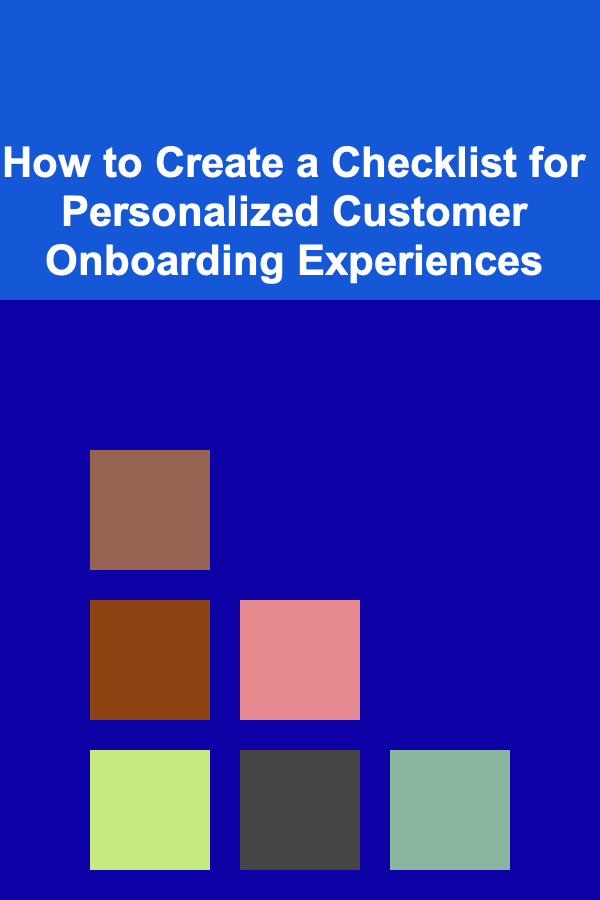
How to Create a Checklist for Personalized Customer Onboarding Experiences
ebook include PDF & Audio bundle (Micro Guide)
$12.99$11.99
Limited Time Offer! Order within the next:

Customer onboarding is a critical process in ensuring that new users or clients feel welcomed, informed, and empowered to use your product or service effectively. A personalized onboarding experience can significantly improve customer satisfaction, retention, and ultimately, drive long-term loyalty. By crafting a tailored onboarding journey, businesses can help their customers feel valued, reduce churn, and increase their overall success with the product.
In this actionable guide, we'll explore how to create a checklist for a personalized customer onboarding experience, providing you with a comprehensive framework to improve your onboarding process step by step.
Understand Your Customer Segments
Before you even begin creating an onboarding checklist, it's essential to understand your customer segments. Personalization starts with understanding the different types of users or clients who will be going through your onboarding process. Every customer has unique needs, and by segmenting them based on factors like industry, experience level, or use case, you can tailor the onboarding experience to be more relevant.
Steps for Segmentation:
- Demographics and Firmographics: Consider factors such as the size of the company, industry, geographic location, and job title.
- Behavioral Data: Look at past user behavior or historical data such as how they interact with your website, which features they tend to use, or where they might drop off.
- Needs Analysis: Conduct surveys or interviews to better understand specific customer pain points or desired outcomes.
By gathering this information, you'll create a roadmap that helps you design an onboarding experience that resonates with each segment.
Map Out Key Customer Journey Touchpoints
The customer journey consists of multiple touchpoints where users engage with your product. These touchpoints, whether digital or personal, will determine the success of your onboarding process. A personalized onboarding checklist should include all the critical stages that customers go through, from initial sign-up to becoming a loyal, active user.
Key Touchpoints:
- Sign-Up/Account Creation: This is the very first step in the journey, and it's crucial to make this as seamless as possible. For personalized experiences, consider offering different sign-up methods based on customer preferences, such as using social media logins or company-specific domains.
- Welcome Email or Message: Send a personalized welcome message that addresses the customer by name and mentions the unique features relevant to them.
- First Product Interaction: Ensure customers are guided through the main product features that directly align with their goals or needs.
- Follow-Up Checkpoints: Send regular follow-up emails or messages that track progress, suggest relevant features, or offer additional support.
How to Implement:
- Create a timeline of customer touchpoints from the first interaction to long-term use.
- Personalize each step based on customer segments, offering specific resources, tips, and assistance at the right time.
Define Clear Onboarding Goals and Objectives
Each customer journey should have clear objectives tied to success. For an onboarding experience to be effective, both you and the customer need to know what success looks like. These goals could range from understanding the core features of your product to achieving specific milestones that demonstrate the product's value.
Examples of Onboarding Goals:
- User Engagement: Ensure users interact with a core feature of the product within the first 48 hours.
- Account Setup: Help users complete profile setup and integrate other necessary tools or software.
- Feature Adoption: Track whether the customer starts using premium features or other functionalities that will benefit them long-term.
How to Implement:
- Break down onboarding into clear, measurable stages.
- Align personalized content with each milestone so customers are always aware of their progress.
Tailor Content and Resources Based on User Profiles
A personalized onboarding experience is one where the content, training, and resources are carefully tailored to the individual customer. Instead of offering a generic set of instructions or tutorials, personalize the content based on the customer's specific needs, preferences, and behavior.
Types of Personalized Content:
- Onboarding Emails: Customize the subject line and content based on the user's role, industry, or goals.
- Interactive Walkthroughs: Offer personalized walkthroughs based on the features the user is most likely to need first.
- Videos & Tutorials: Create short, easy-to-digest tutorial videos that explain the features most relevant to the user's profile.
- Help Center Articles: Provide easy access to resources that target the user's unique challenges or use cases.
How to Implement:
- Use dynamic content tools and automation platforms that adapt content based on customer data.
- Continuously gather feedback to refine and personalize the resources offered.
Provide Dedicated Support and Communication Channels
A key aspect of personalized onboarding is ensuring that customers have the support they need when they need it. Offering real-time assistance or accessible support options will go a long way in making the experience smoother and more enjoyable. Whether it's through live chat, email, or phone support, make sure users feel like they are never alone during the onboarding process.
Support Strategies:
- Live Chat Support: Integrate live chat on your website or product platform to provide immediate assistance. Customize chatbots to recognize common onboarding queries.
- Personalized Check-Ins: Schedule one-on-one calls or video sessions with a customer success manager, especially for high-value customers.
- Help Desk Integration: Make sure your support platform is integrated with your product so that users can easily find answers to common questions or issues.
How to Implement:
- Implement a seamless support system where users can easily transition from self-help resources to live assistance.
- Provide proactive, not just reactive, support by reaching out at key stages in the onboarding process to offer assistance.
Encourage User Feedback Throughout the Onboarding Process
Feedback is essential for continuously improving your customer onboarding experience. By asking for feedback regularly, you ensure that users feel heard and can guide the process toward areas that need improvement. This also helps in fine-tuning the personalization of the journey, making it more relevant for future users.
Feedback Methods:
- Surveys and Polls: Integrate simple surveys or polls after each key onboarding touchpoint to assess customer satisfaction and identify pain points.
- In-App Feedback: Include a quick feedback button or form within the product to gather real-time insights.
- Post-Onboarding Reviews: After the onboarding process is complete, ask for a review or interview to better understand what worked and what didn't.
How to Implement:
- Use survey tools like Typeform or Google Forms, or incorporate feedback options directly into your product or onboarding flow.
- Analyze feedback to refine the onboarding process continuously.
Track Key Metrics and Analyze User Behavior
Tracking key performance indicators (KPIs) is crucial to measuring the effectiveness of your onboarding process. Metrics like activation rate, user engagement, and retention can provide valuable insights into how well your onboarding is performing and where it can be improved.
Key Metrics to Track:
- Time to First Action: Measure how long it takes for users to complete their first meaningful action (e.g., making a purchase, creating their first project).
- Drop-Off Rate: Identify at which points customers tend to drop off during the onboarding process.
- Feature Adoption: Track which features users are engaging with most and where there are opportunities to introduce additional features or resources.
How to Implement:
- Use analytics tools like Google Analytics, Mixpanel, or Heap to track user behavior during the onboarding process.
- Set up goals and triggers to track important user milestones and refine the process based on data.
Keep the Onboarding Process Scalable
As your business grows, so will the number of customers who need to be onboarded. It's essential to design your personalized onboarding process in a way that can scale efficiently without losing the personal touch. This may involve automating certain parts of the process while still keeping customization at the core.
Scalability Tips:
- Automation: Use automation tools to trigger personalized onboarding emails or steps based on user actions.
- Modular Training: Create a modular onboarding experience where customers can choose which learning path or features to explore next, depending on their needs.
- Customer Segmentation: Automatically segment new users based on their profile and tailor the onboarding flow to each segment.
How to Implement:
- Utilize onboarding software like ChurnZero or Appcues, which allow for scalable personalization.
- Set up automated workflows that adapt to user actions and provide personalized content at scale.
Conclusion
Creating a personalized customer onboarding experience requires a thoughtful approach, leveraging data and technology to ensure that each user feels valued, understood, and empowered. By mapping out the customer journey, segmenting users, tailoring content, providing dedicated support, gathering feedback, and tracking success, businesses can optimize their onboarding processes and set customers on a path toward success. A great onboarding experience isn't just about introducing the product---it's about making sure customers have the tools and support they need to thrive, ensuring long-term satisfaction and loyalty.
Reading More From Our Other Websites
- [Home Cleaning 101] How to Clean Your Refrigerator and Keep It Smelling Fresh
- [Home Storage Solution 101] How to Use Storage Ottomans to Keep Your Living Room Neat
- [Personal Care Tips 101] How to Choose the Best Hand Cream for Summer Months
- [Home Party Planning 101] How to Make DIY Party Favors That Are Both Budget-Friendly and Thoughtful
- [Home Rental Property 101] How to Rent a House with a Man Cave: A Must-Have Feature for Modern Dads
- [Home Family Activity 101] How to Plan a Fun Family Staycation
- [Home Budget Decorating 101] Best DIY Budget Decorating Projects: Transforming Your Home with Creative Upcycling
- [Organization Tip 101] What Should You Consider When Organizing Your Home Office Layout?
- [Organization Tip 101] How to Maintain the Value of Your Antique Collection
- [Personal Care Tips 101] How to Use Antiperspirant to Avoid Discomfort and Sweating

How to Create a Visual Board for Camp Themes and Goals
Read More
How to Curate Your Apartment Décor for a Cohesive Look
Read More
How to Keep Pet Supplies Safe from Pests and Critters
Read More
How to Remove Stubborn Carpet Stains Without Chemicals
Read More
How To Build a Simple Outdoor Table
Read More
How to Write Clean and Maintainable JavaScript Code
Read MoreOther Products

How to Create a Visual Board for Camp Themes and Goals
Read More
How to Curate Your Apartment Décor for a Cohesive Look
Read More
How to Keep Pet Supplies Safe from Pests and Critters
Read More
How to Remove Stubborn Carpet Stains Without Chemicals
Read More
How To Build a Simple Outdoor Table
Read More